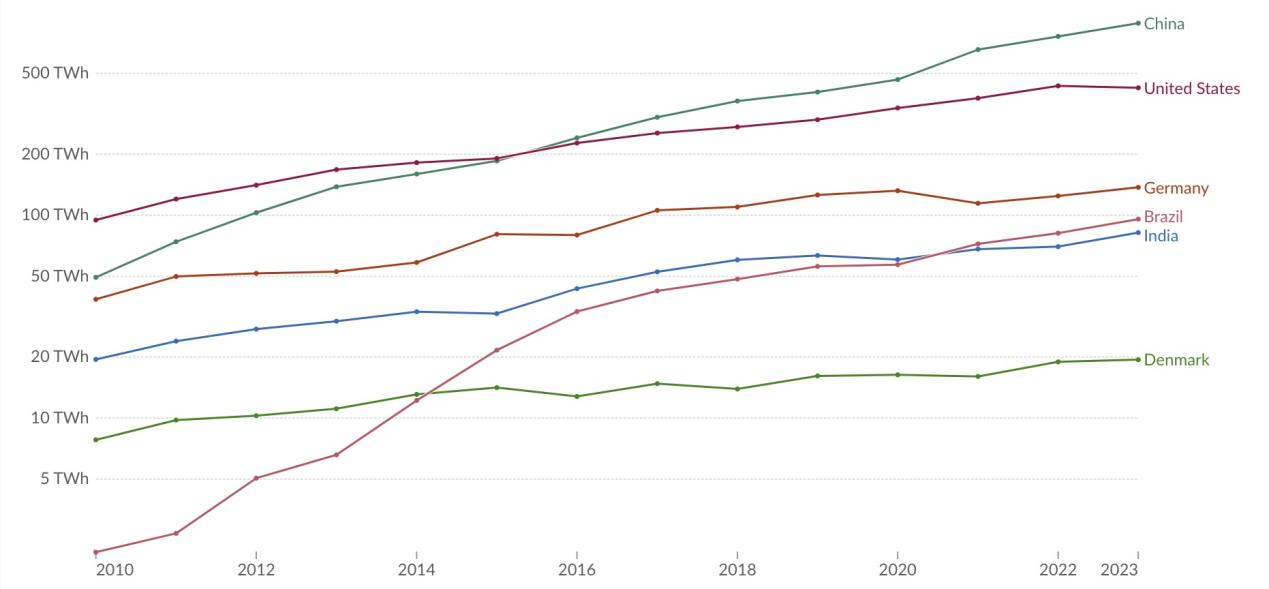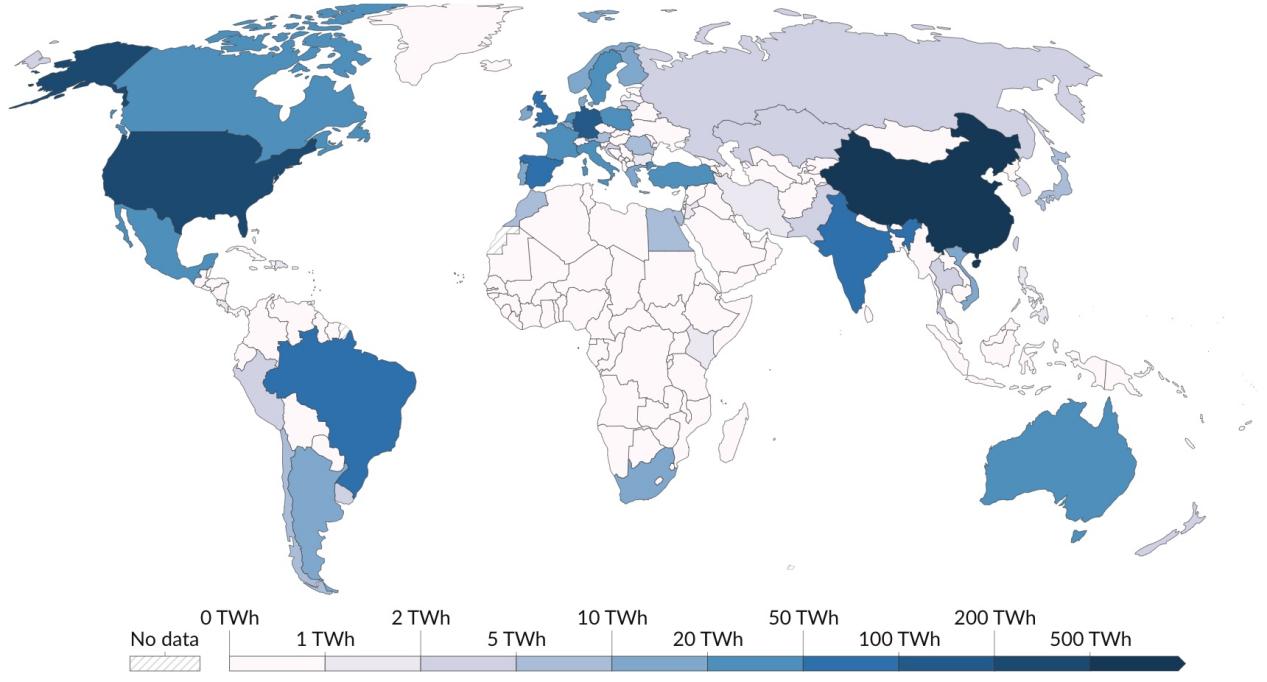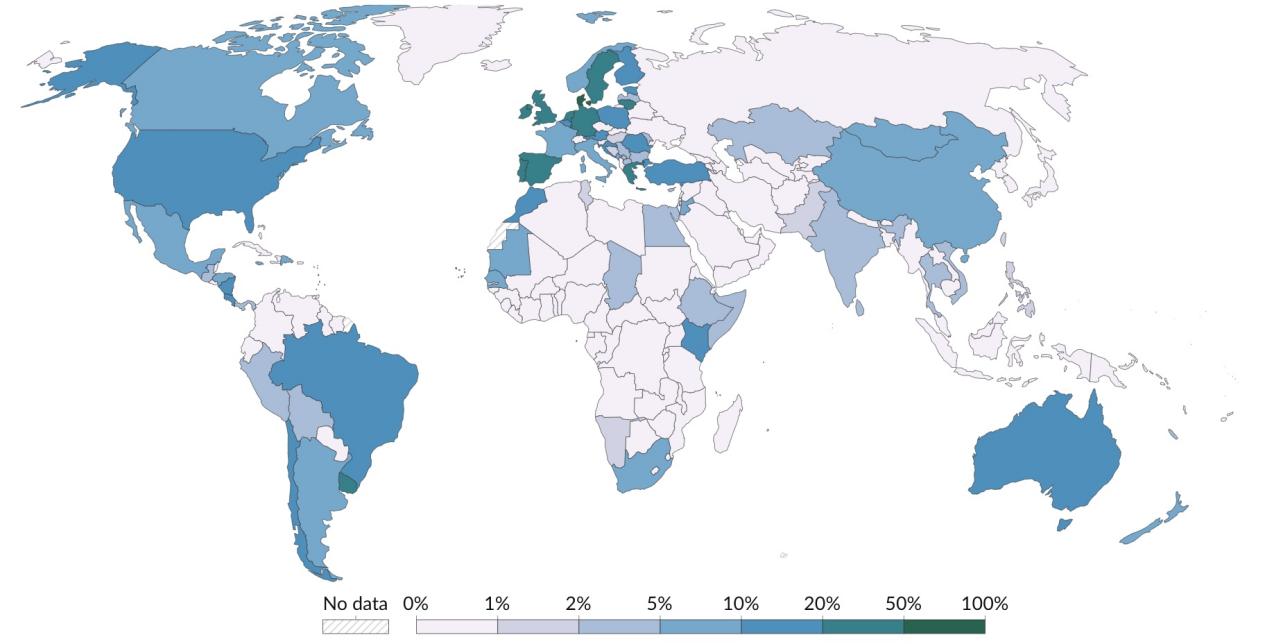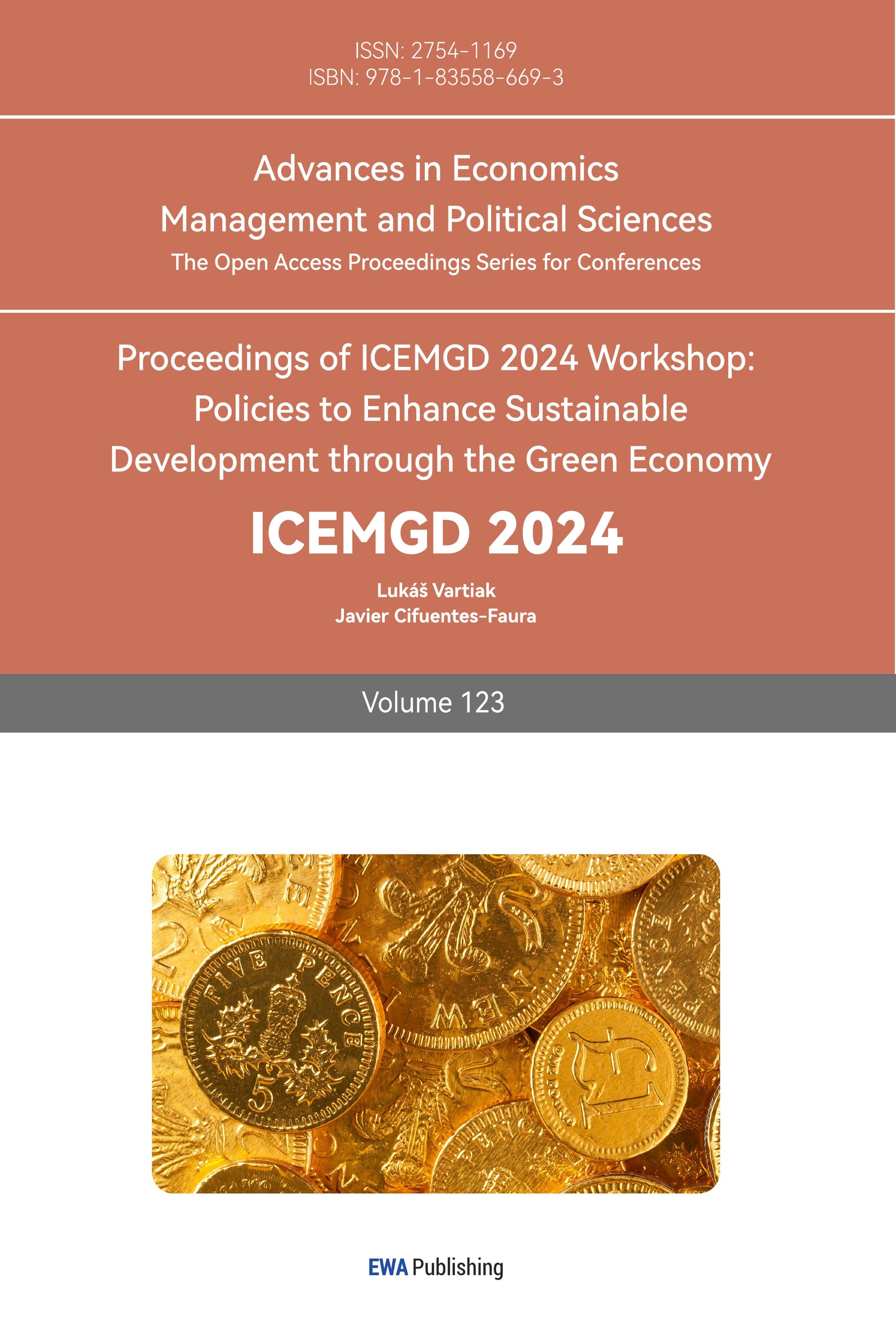1. Introduction
Energy is one of the most important issues affecting any country's economic, industrial, and environmental situation. The world urgently needs renewable energy to combat climate change, reduce greenhouse gas emissions, and ensure a sustainable energy future. Wind energy is important because it is abundant, renewable, and creates no emissions during operation, making it an essential factor in lowering reliance on fossil fuels and minimizing environmental concerns.
Wind energy is the energy harnessed from air movement. It has been utilized for centuries, initially in windmills for tasks such as grinding grain and pumping water. Today, it is primarily used to generate electricity through wind turbines.
Wind energy has emerged as one of the world's fastest increasing sources of electricity. According to the Global Wind Report, 2023, global wind power capacity reached 907 gigawatts (GW), producing around 6.6% of the world’s electricity [1]. This represents a huge increase from 743 GW in 2020, indicating an increasing position in the global energy mix.
This study attempts to provide a thorough knowledge of how wind turbines operate and how their efficiency is evaluated, thereby analyzing the potential problems and possible improvements of wind turbines.
2. Background of Wind Energy
Wind turbines were first harnessed for sailing in 5000 BC; wind-powered water pumps were invented in the 11th century. In the 1800s, farmers in the United States used windmills for water pumping, grain grinding, and wood cutting. Small wind-electric generators became more widely used in the late 1800s - early 1900s. Between the 1970s and 1980s, oil/gas shortages rekindled interest in wind. From the 2010s to the present, offshore wind is being developed.
Wind energy is classified into three major categories based on its location: land-based wind, offshore wind, and distributed wind. Land-based wind, also known as onshore wind energy, refers to wind turbines that are built on land and are typically found in rural areas or in areas with strong and consistent winds. Onshore wind farms are easier and less expensive to develop and maintain than offshore wind farms. Offshore wind energy involves installing wind turbines in bodies of water, usually on the continental shelf. These turbines harness stronger and more consistent winds at sea, leading to better energy production. Offshore wind farms are larger and farther away from populated areas, decreasing visual and noise concerns. However, they are more expensive to create and maintain. Distributed wind energy is defined as small-scale wind facilities that generate power for local usage, often at or near the point of consumption. These systems can be onshore or offshore and are commonly used to power homes, farms, businesses, and small villages. Distributed wind systems reduce transmission losses and improve energy security by offering a local, renewable energy source. They can also work with renewable energy systems such as solar panels to build a more resilient and sustainable grid.
Research shows that China and the United States lead in wind power generation, with China experiencing a significant increase, surpassing 800 TWh by 2023 (Figure 1). The United States follows with approximately 400 TWh. Countries like Germany, Brazil, India, and Denmark have lower wind power generating levels, producing less than 150 TWh annually.

Figure 1: Annual wind power generation by country in 2023 [2]
The global distribution map (Figure 2) shows that China and the United States dominate wind power, with significant contributions from Europe and South America. This statistic highlights major regional variances in wind energy uptake and generation.

Figure 2: Global distribution of annual wind power generation in 2023 [2]
Figure 3 illustrates the percentage of power output varies per country. Denmark has the highest rate of wind energy, accounting for over 60% of total energy generation, followed by the United Kingdom (30%). Other countries, such as Australia, the United States, and India, produce less than 10% of their energy from wind.

Figure 3: Percentage of electricity generated from wind by country in 2023 [2]
3. Wind Turbine Operation and Efficiency Calculation
3.1. Wind Turbine Operation
In principle, wind turbines transform the kinetic energy of wind into electrical energy. When the wind blows, it turns the turbine blades, generating mechanical energy. This mechanical energy is transferred from the rotor to the gearbox, which increases the rotational speed to a level sufficient for power generation. The high-speed rotation is then passed to the generator, which converts it into electrical energy through electromagnetic induction. This electrical energy flows to a power interface, allowing the electricity to meet grid requirements and ensuring stable and efficient delivery. Finally, the conditioned electrical energy is delivered to the grid, which provides power for a variety of applications [3].
Wind turbines are classified into two types: horizontal axis (HAWT) and vertical axis (VAWT). HAWTs have blades that rotate around a horizontal axis and resemble conventional windmills. They are more prevalent and effective, particularly in wide locations with continuous wind. VAWTs have blades that rotate around a vertical axis and can capture wind from all directions. They are less efficient but operate better in turbulent environments and require less maintenance. This study focuses on HAWTs because they are more commonly applied.
HAWT uses a sophisticated structure and system of components to collect wind energy, which includes the wind turbine tower, blades, hub, rotor, nacelle, generator, gearbox, controller, anemometer, yaw system, and wind vane. To begin, the wind turbine tower provides structural support for the wind turbine while also lifting the rotor and blades to capture greater winds at higher heights. A central hub connects the three blades to form the rotor. When wind blows, the blades rotate, transforming kinetic energy into mechanical energy. Furthermore, the hub connects the blades to the nacelle, which houses critical components like the gearbox, generator, and controller. The gearbox boosts the blades' rotating speed to a level appropriate for power generation. The generator then converts the rotor's mechanical energy to electrical energy. The controller monitors system performance and adjusts parameters for efficiency and safety. The wind vane detects wind direction while the anemometer measures wind speed. These instruments provide data to the yaw system, which aligns the turbine with the wind to maximize energy capture. Furthermore, the yaw system placed at the top of the tower guarantees that the rotor is facing the wind by moving the nacelle horizontally. This precise positioning is required for optimal energy generation.
3.2. Energy Efficiency and Influence Factors of Wind Energy
Wind turbine blades generate lift through their curved design. Wind moves faster over the blade's curved upper surface and slower beneath the flat lower surface. The difference in speed causes a pressure differential, with lower pressure at the top and higher pressure below. The pressure differential provides lift, moving the blade perpendicular to the wind direction. The lift force rotates the blades and converts wind energy into mechanical energy [4].
One aspect influencing wind turbine efficiency is the number of blades, typically three. Three blades provide an excellent balance between high energy yield and stability. Fewer blades reduce drag but cause stability issues, while more blades increase drag and decrease energy output.
Wind turbine blade design, particularly pitch, has a substantial impact on wind energy conversion efficiency. Blade pitch is the angle at which the blades are set relative to the wind. Adjusting the pitch improves the aerodynamic performance of the blades.
When the blade pitch is set correctly, it maximizes the lift force generated by the wind, enhancing rotational speed and energy output. In low wind conditions, the blades are pitched to a steeper angle to capture more wind and increase rotation. Conversely, the pitch is adjusted to a flatter angle in high wind conditions to reduce resistance and prevent potential damage from excessive forces.
Pitch control systems adjust the blade angle to maintain optimal wind turbine performance, ensuring that the turbine operates efficiently across various wind speeds. This adaptability helps maximize energy production and extend the turbine's lifespan. Precise blade pitch control improves wind turbine efficiency and dependability in turning wind energy into electricity.
3.3. Energy Calculation
Turbines get energy from the wind. Outgoing wind has lower speed and kinetic energy than incoming wind after passing the turbine. The turbine's energy is the difference between the kinetic energy of incoming wind and the kinetic energy of outgoing energy (ignoring energy loss).
\( {E_{turbine}}={E_{in}}-{E_{out}} \) (1)
However, the Betz limit restricts the amount of energy a wind turbine can extract. Wind turbines can only absorb up to 59.3% of the wind's kinetic energy, as extracting more would disrupt airflow and reduce efficiency. This limit is applied in wind turbine design and engineering to guide efficiency expectations and improvements. However, real-world factors like mechanical losses, aerodynamic drag, and generator efficiency mean that most turbines achieve about 35-45% efficiency.
To calculate energy potential from the wind passing through a wind turbine, we use the following formula:
\( P=\frac{1}{2}ρA{V^{3}} \) (2)
In the equation, P is the power in watts (W), ρ is the air density in kg/m³, which is normally approximately 1.225 kg/m³ at sea level, A is the swept area of the turbine blades in square meters (m²), A = πr2 for a turbine with blade length r, and v is the wind speed in m/s.
The power coefficient (Cp) measures how efficiently a wind turbine transforms kinetic energy into mechanical energy. It is the ratio of the turbine's actual power output to the theoretical maximum power attainable in the wind. The upper limit of Cp is 59%.
\( CP=\frac{{P_{turbine}}}{{P_{wind}}} \) (3)
Wind turbines never operate at peak power continuously year-round because of occasionally slow wind speed, maintenance, and variable energy demand from the grid. Capacity factor, therefore, serves as a measure of the actual output of a power plant compared to its maximum possible output over a specific period. It is expressed as a percentage and provides insight into how efficiently a power plant is utilized.
\( Capacity Factor (CF) =\frac{Actual Energy Output}{Maximum Energy Output} \) (4)
4. Problems and Solutions
4.1. Advantages
It is widely known that wind energy has numerous benefits. It is a renewable and sustainable power source that generates electricity from wind without depleting resources. Wind turbines emit no greenhouse gases in the operation process, resulting in a substantially lower carbon footprint than fossil fuels. Wind energy can help to diversify energy supply, improve energy security, and reduce dependency on imported fuels. Once built, the system has relatively low operational expenses, and advances are constantly improving efficiency and lowering prices. Wind farms can also coexist with agricultural land, generating additional revenue for landowners and fostering economic growth.
4.2. Problems and Limitations
The problems and limitations of wind energy prevent it from being more efficient. Firstly, inadequate research during site selection would lead to low energy production output. Wind turbines require a minimum wind speed to generate power, typically around 3-5 m/s, and achieve optimal efficiency at higher speeds, usually between 12-15 m/s. Locations with insufficient wind speeds or highly variable wind patterns will not generate power efficiently, leading to lower energy output and reduced overall effectiveness [5]. Geographic and topographic features also play a significant role in site selection. Turbines placed in areas with significant terrain obstructions, such as hills or tall buildings, may experience wind turbulence, disrupting the smooth flow of air and reducing energy conversion efficiency. The distance from existing infrastructure is another limiting factor. Wind farms situated far from power grids or storage facilities face higher costs for transmission infrastructure, which can diminish the project's economic viability. Long transmission lines also increase energy losses, further reducing the overall efficiency of the wind energy system [6].
Besides, noise and aesthetic considerations substantially impact wind energy development because they influence public opinion and acceptance of wind farms. Wind turbines produce noise due to mechanical components and blades' aerodynamic interaction with the wind. Land-based, utility-scale wind turbines create average sounds of 35-45 decibels when heard from 300 meters away, according to research [7]. This loudness may irritate surrounding neighbors, especially in rural or suburban regions where ambient noise levels are low. Persistent noise can cause health issues such as sleep problems and stress, generating criticism from surrounding residents and resulting in stronger turbine placement and operation rules. Aesthetic concerns also play a crucial role in limiting wind energy development. Wind turbines, often towering over 100 m, can dominate the landscape, altering the visual appeal of natural and rural settings.
Moreover, the environmental impact on animals, particularly birds and bats, limits wind energy development. The construction and management of wind farms might affect local habitats and migration routes. These environmental concerns might result in stricter restrictions and the necessity for detailed ecological impact assessments, which raises project costs and schedules.
4.3. Improvement and Solutions
To improve wind energy and foster its development, addressing the problems listed above is crucial. First, optimizing site selection is critical for maximizing energy output and minimizing adverse effects. Advanced wind resource assessment tools, including computer simulations and wind mapping, can identify locations with optimal wind speeds and consistency. Prioritizing sites with high wind potential ensures efficient energy production. Avoiding areas with significant obstructions, such as hills or tall buildings, reduces turbulence and enhances energy capture. Collaboration with meteorologists and engineers can refine site selection, ensuring that turbines are placed in locations that maximize energy yield while minimizing disruptions.
Second, addressing noise and aesthetic concerns is essential for gaining public acceptance and support. Noise can be mitigated through technological advancements and strategic planning. Implementing quieter turbine designs, such as those with optimized blade shapes and reduced mechanical noise, can significantly decrease the sound produced. Additionally, variable-speed turbines vary rotating speeds dependent on wind conditions, reducing noise during low wind speeds [8]. Acoustic barriers or vegetation buffers around wind farms can also dampen noise propagation, creating a more acceptable noise level for nearby residents. To address aesthetic concerns, do thorough visual impact assessments during the planning process. Engaging with local communities to understand their preferences and concerns can guide turbine placement to minimize visual intrusion.
Third, mitigating environmental impacts, particularly on wildlife, is crucial for sustainable wind energy development. Conducting thorough environmental impact assessments (EIAs) before construction can identify potential risks to local wildlife, including birds and bats [9]. Once potential impacts are identified, strategies to minimize harm can be implemented. To reduce bird and bat collisions, technologies such as ultrasonic deterrents and blade-mounted devices that emit sounds to warn animals can be employed [10]. Painting one blade of the turbine black has shown promise in making turbines more visible to birds, reducing collision rates. Additionally, avoiding migration corridors and sensitive habitats during site selection can further protect wildlife. Implementing shut-down-on-demand systems, which temporarily halt turbine operations during peak migration periods, can significantly reduce the risk to wildlife.
5. Conclusions
To summarize, this passage aims to find solutions to improving the energy efficiency of wind turbines by analyzing the functionality of components of wind turbines.
The functionality of wind turbines shows the intricate engineering and technological sophistication required to harness wind energy efficiently. The interaction of numerous components, from the tower and blades to the gearbox and generator, demonstrates the complexities involved in transforming wind kinetic energy into useful electrical power. Optimizing wind energy systems requires calculating wind energy potential as well as understanding the power coefficient and capacity factor. These parameters inform the design and operation of wind turbines, increasing their efficiency and effectiveness.
Wind energy faces significant challenges that must be addressed to realize its full potential. Site selection is critical, as turbines must be located in locations with excellent wind speeds and little impediments to achieve maximum energy output. Noise and aesthetic concerns might impede public acceptance and support, needing technological advances and strategic planning to address these challenges. The environmental impact on wildlife, especially birds and bats, must be carefully assessed and mitigated.
To improve wind energy's viability and expand its adoption, targeted strategies must be employed. Advanced wind resource assessment tools can refine site selection processes, ensuring turbines are placed in locations that maximize energy yield while minimizing disruptions. Technological advancements in turbine design can reduce noise levels and address aesthetic concerns, fostering greater public acceptance. Comprehensive environmental impact assessments and mitigation strategies can protect wildlife and ensure sustainable wind energy development.
Finally, wind energy is crucial for a sustainable and renewable energy future. Addressing problems such as site selection, noise, aesthetics, and environmental effect can improve wind energy efficiency and acceptance. Wind energy has the potential to reduce dependency on fossil fuels, mitigate climate change, and ensure a sustainable energy future for future generations with sustained innovation and strategic planning.
References
[1]. GWEC. (2023) Global Wind Report. Global Wind Energy Council.
[2]. Ember (2024) Energy Institute - Statistical Review of World Energy 73th edition.
[3]. Walford, C. A. (2006) Wind turbine reliability: understanding and minimizing wind turbine operation and maintenance costs (No. SAND2006-1100). Sandia National Laboratories (SNL), Albuquerque, NM, and Livermore, CA (United States).
[4]. Papież, M., Śmiech, S. and Frodyma, K. (2019) Factors affecting the efficiency of wind power in the European Union countries. Energy Policy, 132, 965-977.
[5]. Jung, C. and Schindler, D. (2023) Efficiency and Effectiveness of Global Onshore Wind Energy Utilization. Energy Conversion and Management, 280, 116788.
[6]. Roga, S., Bardhan, S., Kumar, Y. and Dubey, S. K. (2022) Recent Technology and Challenges of Wind Energy Generation: A Review. Sustainable Energy Technologies and Assessments, 52, 102239.
[7]. Christol, C., Oteri, F. and Laurienti, M. (2021). Land-Based Wind Energy Siting: A Foundational and Technical Resource (No. NREL/TP-5000-78591; DOE/GO-102021-5608). National Renewable Energy Lab.(NREL), Golden, CO (United States).
[8]. Li, Z., Tian, X., Wen, B., Ma, H., Ding, W., Song, H. and Peng, Z. (2024) Dynamic Performance Evaluation of Variable-Speed Wind Turbine Transmission System in Non-Stationary Conditions. Journal of Vibration Engineering & Technologies, 12(3), 3133-3153.
[9]. CollingtonWinter. (2023b, April 25). Environmental Impact Assessment of Wind Turbines - CWE. Collington Winter. Retrieved from https://collingtonwinter.com/blog/environmental-impact-assessment-of-wind-turbines/#:~:text=An%20EIA%20allows%20developers%20to.
[10]. Weaver, S. P., Hein, C. D., Simpson, T. R., Evans, J. W. and Castro-Arellano, I. (2020) Ultrasonic Acoustic Deterrents Significantly Reduce Bat Fatalities at Wind Turbines. Global Ecology and Conservation, 24, e01099. https://doi.org/10.1016/j.gecco.2020.e01099.
Cite this article
Liu,Y. (2024). Evaluation and Improvement of Wind Turbine Operation and Efficiency. Advances in Economics, Management and Political Sciences,123,55-62.
Data availability
The datasets used and/or analyzed during the current study will be available from the authors upon reasonable request.
Disclaimer/Publisher's Note
The statements, opinions and data contained in all publications are solely those of the individual author(s) and contributor(s) and not of EWA Publishing and/or the editor(s). EWA Publishing and/or the editor(s) disclaim responsibility for any injury to people or property resulting from any ideas, methods, instructions or products referred to in the content.
About volume
Volume title: Proceedings of ICEMGD 2024 Workshop: Policies to Enhance Sustainable Development through the Green Economy
© 2024 by the author(s). Licensee EWA Publishing, Oxford, UK. This article is an open access article distributed under the terms and
conditions of the Creative Commons Attribution (CC BY) license. Authors who
publish this series agree to the following terms:
1. Authors retain copyright and grant the series right of first publication with the work simultaneously licensed under a Creative Commons
Attribution License that allows others to share the work with an acknowledgment of the work's authorship and initial publication in this
series.
2. Authors are able to enter into separate, additional contractual arrangements for the non-exclusive distribution of the series's published
version of the work (e.g., post it to an institutional repository or publish it in a book), with an acknowledgment of its initial
publication in this series.
3. Authors are permitted and encouraged to post their work online (e.g., in institutional repositories or on their website) prior to and
during the submission process, as it can lead to productive exchanges, as well as earlier and greater citation of published work (See
Open access policy for details).
References
[1]. GWEC. (2023) Global Wind Report. Global Wind Energy Council.
[2]. Ember (2024) Energy Institute - Statistical Review of World Energy 73th edition.
[3]. Walford, C. A. (2006) Wind turbine reliability: understanding and minimizing wind turbine operation and maintenance costs (No. SAND2006-1100). Sandia National Laboratories (SNL), Albuquerque, NM, and Livermore, CA (United States).
[4]. Papież, M., Śmiech, S. and Frodyma, K. (2019) Factors affecting the efficiency of wind power in the European Union countries. Energy Policy, 132, 965-977.
[5]. Jung, C. and Schindler, D. (2023) Efficiency and Effectiveness of Global Onshore Wind Energy Utilization. Energy Conversion and Management, 280, 116788.
[6]. Roga, S., Bardhan, S., Kumar, Y. and Dubey, S. K. (2022) Recent Technology and Challenges of Wind Energy Generation: A Review. Sustainable Energy Technologies and Assessments, 52, 102239.
[7]. Christol, C., Oteri, F. and Laurienti, M. (2021). Land-Based Wind Energy Siting: A Foundational and Technical Resource (No. NREL/TP-5000-78591; DOE/GO-102021-5608). National Renewable Energy Lab.(NREL), Golden, CO (United States).
[8]. Li, Z., Tian, X., Wen, B., Ma, H., Ding, W., Song, H. and Peng, Z. (2024) Dynamic Performance Evaluation of Variable-Speed Wind Turbine Transmission System in Non-Stationary Conditions. Journal of Vibration Engineering & Technologies, 12(3), 3133-3153.
[9]. CollingtonWinter. (2023b, April 25). Environmental Impact Assessment of Wind Turbines - CWE. Collington Winter. Retrieved from https://collingtonwinter.com/blog/environmental-impact-assessment-of-wind-turbines/#:~:text=An%20EIA%20allows%20developers%20to.
[10]. Weaver, S. P., Hein, C. D., Simpson, T. R., Evans, J. W. and Castro-Arellano, I. (2020) Ultrasonic Acoustic Deterrents Significantly Reduce Bat Fatalities at Wind Turbines. Global Ecology and Conservation, 24, e01099. https://doi.org/10.1016/j.gecco.2020.e01099.









